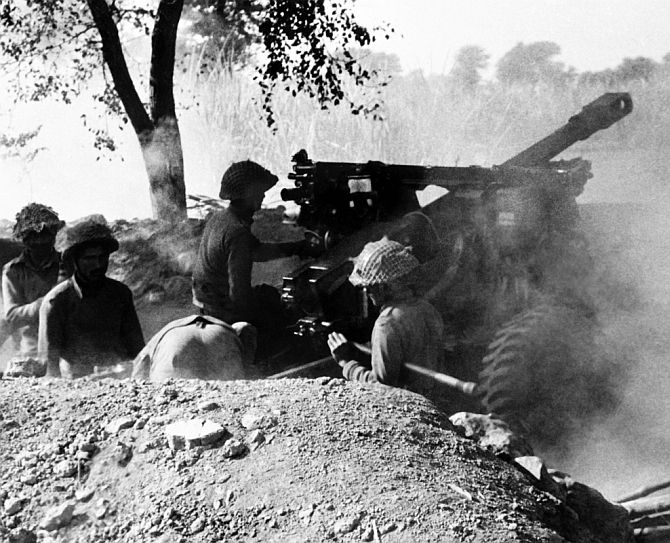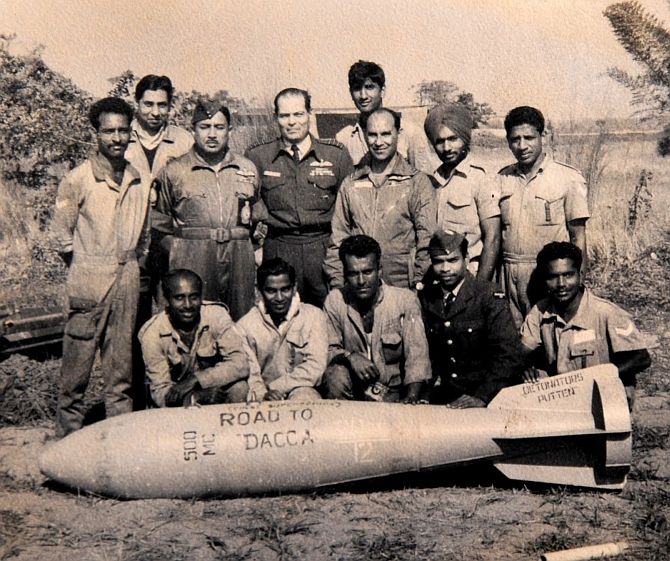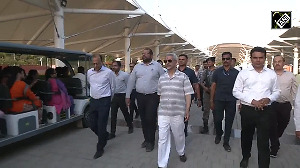Air Vice Marshal Arjun Subramaniam's book India's Wars: A Military History, 1947-1971 is an eye-opener.
India's Wars gives the reader deep insights into little known aspects of combat, the sharp military minds that shaped battlefield tactics and the precision with which they were executed.
Deeply researched and passionately written, Air Vice Marshal Subramaniam -- a fighter pilot who has commanded a MiG-21 squadron and a base comprising India's frontline fighter, the Sukhoi-30MKI -- offers a fresh and extremely readable perspective on modern Indian military history.
Rediff.com brings you an exclusive excerpt from India's Wars about leadership in the 1971 war, India's greatest military triumph, published with the author's kind and gracious permission.

What then were the major operational takeaways from the 1971 war from an Indian perspective?
While much of the current discourse on the 1971 war concentrates excessively on the meticulous military planning and orchestration at the highest level, particularly at Eastern Army Command Headquarters, it is the conversion of that plan into more than just successful operational outcomes that takes pole position.
This was only possible because of the initiative and innovation by field commanders like Lieutenant General Sagat Singh, Captain Swaraj Prakash, Group Captain Wollen and Group Captain Chandan Singh.
Had Sagat Singh not bypassed Akhaura, Bhairab Bazar and Sylhet; had Chandan Singh not responded as he did when it came to urging the Mi-4 helicopter crews to press on regardless as they transported men, logistics, ammunition and artillery guns across the River Meghna; had Wollen not asked his MiG-21 pilots to experiment with steep-dive attacks on Tezgaon airfield; and had Swaraj Prakash and Major General Uban not kept almost half a division tied down in the Chittagong sector, Dacca may not have fallen when it did.
For the first time after Independence, India made serious attempts at shaping the battlefield in the sector of its choice, the eastern sector, before engaging in full-scale operations.
 Whether it was covert operations by small teams of R&AW-trained Mukti Bahini operatives initially, or large battalion-sized incursions from November onwards, the psychological impact of the Mukti Bahini can hardly be disputed.
Whether it was covert operations by small teams of R&AW-trained Mukti Bahini operatives initially, or large battalion-sized incursions from November onwards, the psychological impact of the Mukti Bahini can hardly be disputed.
Lieutenant General Shammi Mehta puts the overall contribution of the Mukti Bahini in the right perspective by praising them effusively:
One of the greatest contributions of the Mukti Bahini was in providing intelligence for manoeuvre. If I had to manoeuvre in a vacuum in Bangladesh, I would have ended up waging attrition warfare like in the western sector. During the initial stages of the war, we almost exactly knew where the enemy was thanks to the Mukti Bahini and later on, even if we did not, we could predict their moves thanks to the inputs given by the Mukti Bahini.
In the western theatre, though, the Indian Army entered the war with a rather defensive mindset much to the chagrin of Lieutenant General Candeth, the commander of the Western Army Command.
The concept of 'Offensive defence', which gained traction from Army HQ, had its merits as the war on the western front unfolded. It called for exploiting fleeting opportunities while retaining a defensive balance; dynamic generals like Pinto exploited this flexibility and tasted success in Shakargarh and Basantar with a refreshingly aggressive approach at every stage.
Up north, an aggressive corps commander like Sartaj Singh managed to stabilise Chhamb and score victory after victory in northern Kashmir, Kargil and Turtok sectors. However, despite making good progress, an inspirational leader like Major General Zorawar Chand Bakshi was held back in a defensive role after making spectacular progress in the Chicken's Neck area. Holding the west was imperative for the success of India's two-front strategy.
General Shammi Mehta highlighted that in all of India's earlier wars, attrition warfare ruled the roost without much success whenever two forces bashed against each other head-on without much success, inspired by what he calls the 'hierarchical inheritance of Montgomery, the grand-dad of attrition warfare'.
He points out that wherever the Indian Army tasted success in 1971, it was because of prosecuting manoeuvre warfare.
Dispelling the widespread notion that only armoured corps officers possessed the mind set of a manoeuvrer, General Pinto, a hardcore infantryman, looked at manoeuvre as a state of the mind and not merely a movement of forces on the ground. He went on further to highlight that proactive and reactive strategies of warfare were merely an extension of manoeuvre and attrition warfare.
Pakistan, he added, were purely reactive in 1971. When asked whether he was surprised that Pakistan did not use their idle armoured division (6 Armoured Division) against his 54 Division, he chuckled and said, 'Had they done so, I would probably not be here talking to you.'
He was equally critical that India's idle and sole armoured division (1 Armoured Division) was not rushed to his sector once he had made inroads. Closing the discussion on the battle of Basantar, he laughed his still infectious laugh and said, 'The offensive-defensive concept still baffles me.'
In the overall context, however, it was a balanced mix of manoeuvre, aggression and offensive defence that resulted in a comprehensive military victory for India.
The next major operational takeaway from a joint perspective was that training, logistics and infrastructure requirements had been well anticipated by India in the six months prior to the war.
Across the border, the Pakistan armed forces had got lethargic and used to the trappings of political power. Their army was mainly engaged in 'mass-killing operations' in East Pakistan, and was not really prepared for war.
When asked how his division trained for war, the ninety-two-year-old General Pinto said, 'We were much better prepared than the formations had been in 1965. As the divisional commander, I spent a lot of time in conceptual thinking and then testing these concepts during sand-model discussions.
'Though the peacetime location of my division was in Secunderabad, we made regular visits to the I Corps HQ at Mathura and onwards to our operational locations. We knew exactly what we had to do when the balloon went up. Intellectual sharpness is essential in modern warfare; the air chief, P C Lal, was one of those with a sharp and incisive mind,' he chuckled.

The ground crew christened the bomb 'Road to Dacca'. Photograph: Kind Courtesy Bharat Rakshak
While the IAF went about building airfields, stringing across air defence networks and developing innovative tactics, the PAF had slackened its usually stringent operational training. It failed to build on the operational successes during the 1965 war despite best attempts by Air Marshal Nur Khan, the PAF chief during the interim years, to keep pace with the IAF.
The IAF gained complete air superiority over East Pakistan in a few days and flew over 2,300 sorties of fighters, helicopters and transport aircraft.
With near parity in the western sector between the IAF and PAF, the IAF flew more than twice the number of sorties in 1971 compared to 1965.
Furthermore, though it was not able to achieve complete air superiority, it was able to keep down the PAF and prevent it from operating to its full potential.
The PAF suffered greater attrition in the 1971 war as compared to 1965 and had to reckon with a resurgent IAF as the war progressed. Interdiction of follow-on forces and operational support requirements by the IAF proved to be quite decisive when it came to denying the Pakistan army of reinforcements when they were needed the most.
The innovative bombing of a Pak artillery brigade in Haji Pir and the largest ammunition dump in the Changa Manga Forest by An-12 transport aircraft led by the brilliant Wing Commander Vashisht contributed immensely to the IAF's deep interdiction campaign. He too was awarded the Mahavir Chakra for his exploits in battle.
Though (Air Chief Marshal P C) Lal had articulated a departure from old aerial strategies, the temptation of creating an impact by Strategic Interdiction was too great and the IAF did carry out some effective strikes on the Kiamari oil refineries at Karachi harbour, Sui gas plant in Sind, Mangala dam and the Attock oil refinery near Rawalpindi.
Even though some Indian military historians have questioned the impact of such strikes on a short war such as the one fought in 1971, their offensive flavour certainly had an impact on the Pakistani mindset and demonstrated India's willingness to strike deep in order to hurt an adversary's economic potential.
Please don't miss the next part on May 17!






 © 2025
© 2025